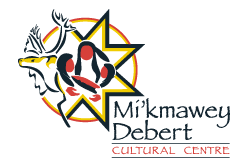Mi'kmawey Debert Cultural Centre Trivia
Congratulations - you have completed Mi'kmawey Debert Cultural Centre Trivia.
You scored %%SCORE%% out of %%TOTAL%%.
Your performance has been rated as %%RATING%%
Your answers are highlighted below.
Question 1 |
The Mi’kmaq have a written language system since before Contact with Europeans, true or false?
False | |
True |
Question 1 Explanation:
The Mi’kmaq have used a system of hieroglyphics, particularly for religious texts, for centuries. Whether the hieroglyphics representations (i.e. memory aids), but words that can be used to write unique phrases. The first recording of hieroglyphics is in 1677 by a Jesuit priest
named Chrestien Le Clercq in the Mi’kmaw community of Nipisiguit along the Miramichi River in New Brunswick. The Mi’kmaw system of hieroglyphics was used to translate numerous religious texts and these texts along the syllabaries can still be found in families and in some museum collections. The use of the hieroglyphics, however, does not change the fact that Mi’kmaw culture is primarily an oral culture in that histories, stories, and everyday life were anchored in conveying knowledge through speaking rather than writing.
Question 2 |
You’re most likely to see an “amaljikwej” in:
Your garbage | |
The forest | |
Lake |
Question 2 Explanation:
Raccoons are clever and adaptable creatures, adjusting well to city life. Remember the next time you’re cleaning up after one; that he thinks you live in his back yard.
Question 3 |
If a Mi’kmaw bids you “Wela’lin,” your response should be:
Thanks. You’re cute, too. | |
Good morning to you | |
You’re welcome |
Question 3 Explanation:
Wela’lin means “thank you”. You could respond in Mi’kmaq with “weliaq”.
Question 4 |
If a Mi’kmaw says “kesalul”, how do they feel about you?
You should run | |
They think you’re weird | |
They love you |
Question 4 Explanation:
“Kesalul” means “I love you”. You might say “kesalul aq nin” (and that means I love you too).
Question 5 |
A “matues” is an animal you should never:
Pat | |
Stand in front of | |
Sniff |
Question 5 Explanation:
Porcupines have sharp barbed quills, which can be painful and difficult if they get lodged in skin.
Question 6 |
In 1841 Grand Chief John Denny Jr. was born. Denny was to become the last hereditary Mi’kmaw Grand Chief to:
Allow squatters to buy Mi’kmaq land | |
Acquire his title by succeeding his father | |
Meet officials in traditional clothing |
Question 6 Explanation:
Mi’kmaw chiefs, whether governing under the provisions in the Indian Act or participating in the Grand Council of Mi’kmaw Chiefs, have since been elected to represent their people.
Question 7 |
The traditional Mi’kmaw dwelling is:
Igloo | |
Longhouse | |
Wigwam |
Question 7 Explanation:
Mi’kmaw wigwams are constructed in a conical shape and covered in birch bark.
Question 8 |
Kejimkujik is a:
Grand chief | |
Ancestral Place | |
Forest spirit |
Question 8 Explanation:
Kejimkujik National Park is located in the southwest region of Nova Scotia. It is home to numerous ancestral sites, including the widely known Mi’kmaw petroglyphs, and connects to the primary river systems in this part of Nova Scotia.
The landscape and the drawings have inspired many Mi’kmaw artists and storytellers, and are considered sacred to many Mi’kmaq.
There continues to be negotiations over the land at Kejimkujik to determine final ownership of this
very important place.
Question 9 |
Ancient Mi’kmaw beliefs honour how many Creator figures?
One | |
Three | |
Seven |
Question 9 Explanation:
There is one Creator. Legends tell of many beings having various degrees of spiritual powers, but only one supreme Creator figure.
Question 10 |
Mi’kmaw language is part of which language family?
Iroquois | |
Algonquian | |
Salishan |
Question 10 Explanation:
The Algonquian language family is the largest in North America and includes numerous indigenous languages stretching from the easternmost shores of Mi’kma’ki to the territories of the Blackfoot and Plains Cree in Alberta to as far south as the state of South Carolina in the United States.
Within the Algoniquian language family there are more than 40 languages.
Once you are finished, click the button below. Any items you have not completed will be marked incorrect.
There are 10 questions to complete.
|
List |

 sharing our stories
sharing our stories